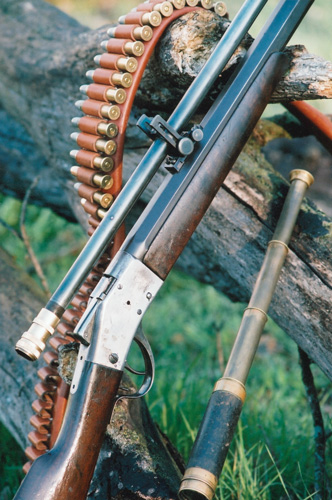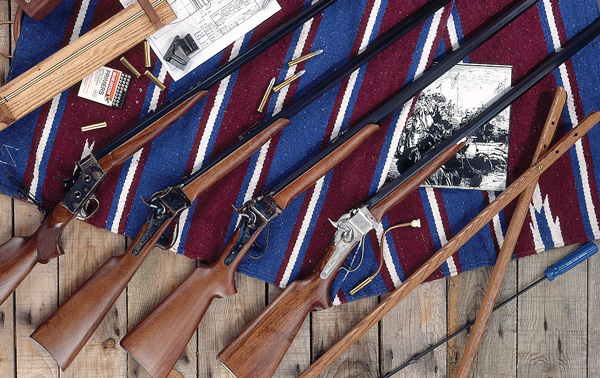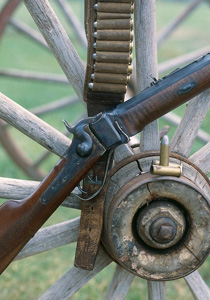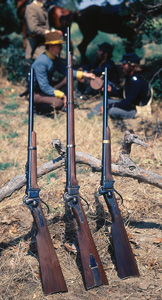

Of the half-million or so “breech-loading” rifles and carbines purchased from twenty different arms makers by the U.S. Ordnance Board during the Civil War, nearly 20 percent were produced by the Sharps Rifle Manufacturing Company, of Hartford, Conn. The only other breech-loaded firearms to see greater use were produced by the Spencer Repeating Rifle Company, of Boston, Mass.
Official records of ordnance purchased by the United States government from January 1, 1861 to June 30, 1866 show that a total of 80,512 carbines and 9,141 rifles of Sharps manufacture were delivered. During that same period, Spencer produced a total of 94,196 carbines and 12,471 rifles for the war.
Mounted cavalry troops tended to prefer the 7-shot repeating Spencer lever-action carbines and easier loading self-contained cartridges over the slower loading single-shot percussion breech-loaded Sharps with combustible paper or linen cartridges. On the other hand, the rugged construction and longer-range accuracy of the Sharps made it revered among foot soldiers. And it was the outstanding reliability of Sharps-built rifles or carbines during this period that earned them their well-deserved “Old Reliable” reputation.
Oddly enough, the man whose name became known around the world, thanks to the quality and accuracy associated with Sharps rifles, had very little to do with the company during this period. And he had no involvement with the production of the later big-bore cartridge rifles that were even better known for their long-range large game taking performance.
Christian Sharps learned the gun-making trade during the 1830s while working with the production of the Hall breech-loading Model 1819 flintlock rifle produced at Harpers Ferry Arsenal.
While Hall later developed a percussion version, Sharps had conceived a still better “drop block” design and received his first patent in September of 1848. Only about 200 each of his percussion Model 1849 and Model 1850 drop-block action rifles were produced by Pennsylvania based manufacturer A.S. Nippes. Both were 44-caliber rifles, built with automatic priming systems.
Production of the 52-caliber Model 1851 and Model 1852 rifles was moved to the Robbins & Lawrence plant in Windsor, Vt. The rifles were built for the newly formed Sharps Rifle Manufacturing Company, headquartered in Hartford, Conn. During the production of the Model 1853 and Model 1855 rifles, both the Robbins & Lawrence and Sharps firms suffered significant losses. The Sharps Rifle Manufacturing Company then moved all manufacturing to Hartford.
The Sharps Rifle Manufacturing Company had been established in 1851 by a group of investors. And Christian Sharps’ role in the operation had been relegated to “Technical Advisor.” His only real tie to the company was that the rifles were being produced under his patents, and Sharps received a $1 royalty for every rifle built. In 1853, Sharps left the company that bore his name, moved to Philadelphia, and opened a new arms-making firm known as C. Sharps & Company, specializing in small pocket pistols and derringers.
Other than a small-bore 31- and 38-caliber percussion drop-block rifle built in the late 1850s, the only other “long guns” actually produced by Christian Sharps were the Sharps & Hankins 52 rimfire single-shot carbines and rifles produced from 1861 to 1867. Sharps died March 12, 1874 at age 64.
All of the Sharps rifles produced up through the Model 1855 were of the original “slant breech” design. Shooters of the time who had the opportunity to use the Sharps breechloaders acknowledged that they were the best firearms available. Christian Sharps’ original design was a definite improvement over other early breech-loading single-shot rifle designs, but did experience considerable gas leakage between the rear of the barrel and face of the breechblock.

The “straight breech” block design that first appeared on the New Model 1859 did help alleviate some of the gas leakage. The rifles and carbines built on through the Civil War with New Model 1863 and New Model 1865 markings generally reflect improvements to further reduce the escape of gases from a burning powder charge. Basically, these Sharps guns were all the same design, based on the New Model 1859.
The 115,000 rifles and carbines produced from 1859 to 1866 represented approximately 65 percent of the total number of Sharps breechloaders ever manufactured. No other official military arm of the Civil War went on to remain as popular with civilian shooters and hunters, not even the Remington rolling block rifles. While the latter went on to be produced in far greater numbers, the true rolling block action was not perfected until about 1866.
The Sharps dropping-block action lent itself well to making the transition from percussion ignition to handling the newly developed cartridges that evolved quickly following the end of the war. In fact, in 1867 the U.S. Government decided to convert or have converted a number of percussion military arms into metallic cartridge breechloaders. And the Sharps was one of the designs selected for conversion.
In all, the Sharps Rifle Manufacturing Company converted 31,098 carbines and 1,086 rifles to accept one or the other of the experimental 52-70 rimfire, 52-70 centerfire or 50-70 centerfire cartridges. All were fitted with new breechblocks with firing pins and an extractor. Those converted to the 50-70 cartridge also required soldering a new 50-caliber barrel liner in place. In 1870, Springfield Armory additionally converted about 1,300 more Sharps rifles and carbines to the newly designated 50-70 Government cartridge.
From 1869 to 1871, the Sharps Rifle Manufacturing Company produced their first entirely “new made” cartridge model – the Sharps New Model 1869. What really set this model apart from the converted percussion military models was the much cleaner looking lockplate, which had been trimmed of the pellet priming system that gave the Civil War-era percussion models a “high hump” contour. The lines of the new lockplate were a lot cleaner.
In all, only about 1,000 New Model 1869 carbines and rifles were produced, chambered for early cartridges like the 44-77 Sharps and 50-70 Government. That production also included about 200 sporting rifles that would set the stage for the famous Model 1874 Rifle, which became the favored gun of the professional buffalo hunter.
The rifle that shooters today most recognize as the “Sharps” thanks to recent movies like Quigley Down Under, is the Model 1874, which actually saw its earliest production in 1871. The feature that probably best helps identify an early Model 1874 from the New Model 1869 is the thickness of the lockplate.
The plates of earlier percussion models, built with the pellet priming system, were 3/8-inch thick, as was the plate of the New Model 1869. The thickness of the lockplate found on the newest cartridge model had been thinned to half that thickness. The “Model 1874” markings were not used on the rifle until after several years production. Sharps’ famous “Old Reliable” trademark began to show up on the barrels in 1876, after the company, then known as just Sharps Rifle Company, had moved to Bridgeport, Conn.
The Model 1874 was chambered for a variety of cartridges during the ten years that it was in production, from “small-bore” 40-caliber centerfires to “big-bore” 50-caliber centerfires. Two favorites of the buffalo hunter were the 50-90 Sharps and 45-100 Sharps. The special order 45-120 Sharps and 50-140 Sharps cartridges were basically introduced too late to have been used extensively during the decimation of the American bison, which by 1880 were so scarce that it was no longer feasible to market-hunt the big animals.
Most Sharps collectors and historians tend to recognize the Model 1877 as the most refined and graceful of the side-hammer single-shot rifles. Only about 100 of the rifles were produced, in 45 caliber, in 1877 and 1878. These were built to comply with the “Creedmoor” match competition rules that required a single trigger and a rifle weighing 10 pounds or less. To get the weight down, Sharps Rifle Company built the Model 1877 with a slim and trim back-action lock and much lighter receiver.
The rifle was built with a nicely checkered pistol grip buttstock and Schnable forend. (The company also produced a few Model 1874 Creedmoor rifles chambered for the 44-90 Sharps Bottleneck cartridge.)
The last model ever produced by the Sharps Rifle Company was the Model 1878 Sharps-Borchardt. This was a very modernistic “hammerless” rifle that has only been somewhat duplicated by more recent single-shot designs like the Ruger No. 1. Lighter than the Model 1874, which was still in production, the Borchardt model was most commonly chambered for the easily available 45-70 Government cartridge, as well as other smaller calibers like the 40-50 Sharps.
The vast majority of the different variations available weighed in at less than 10 pounds. Other than the hammerless drop-block action, the one other feature that set this model apart from other Sharps rifles was a sliding safety. The company produced about 8,700 of the rifles before ceasing the manufacture of all Sharps rifles.
Along with the demise of the great buffalo herds of the West also came the demise of Sharps rifle production. Shooters and hunters no longer had a need for a rifle that consumed powder and lead in such great quantities. And Sharps Rifle Company found it increasingly difficult to compete with the new repeating lever-action rifle models produced by Winchester. Thus, manufacturing at the Sharps plant in Bridgeport, Conn. ceased in 1880, with the last assembled rifles shipped in 1881. During the 32 years of Sharps rifle production, only about 160,000 rifles were ever built. However, those rifles solidly established a legacy that few other rifles have ever come close to matching.
The Modern Sharps Reproduction
It may or may not be entirely correct to claim that more rifles of Sharps’ design have been built in the past 32 years than during the entire 32-year run of original Sharps rifle production – but the modern total wouldn’t miss it by much!
In the summer of 1974, two entirely different companies, separated by an ocean, independently set out to make a somewhat faithful modern-manufactured copy of the original Civil War-era percussion Sharps breechloaders. One was a relatively new U.S. firm known as Shiloh Products, Inc., the other a well-established Italian manufacturer of high quality double shotguns known as IAB Arms. And both were successful.
A draftsman and technical illustrator by trade and blackpowder shooter by heart, Len Mule’ was the real mastermind behind what would become known as the Shiloh Sharps. Before making the decision to completely manufacture a “reproduction” of the famous breech-loaded rifles and carbines, he was manufacturing extremely high quality bullet moulds for blackpowder shooters. The four-cavity design of Mule’s moulds earned them a solid reputation for producing a lot of round balls or Minie’ bullets quickly – up to 400 per hour. They were sold as the “Shiloh IV” moulds. The company also offered quality lead furnaces as well, along with a few other bullet casting products.
Through 1973 the 1974, Len Mule’ devoted much of his life to researching Sharps breech-loading rifles and carbines. Not only did he read everything he could find in print, he also visited major museums, including the West Point Museum and the Smithsonian, consulted with leading Sharps experts and collectors in this country, and spent hundreds of hours looking over hundreds of original rifles. One of those experts was Frank M. Sellers, the author of the acclaimed book, Sharps Firearms.
In late summer 1974, Mule’ and his partner, Wolfgang Droege, visited Dixie Gun Works, in Union City, Tennessee. (At that time, the author was working there as an antique arms buyer and Dixie’s catalog editor.) When they left, with them they took a huge selection of original Sharps parts to use for making new tooling. And when these two entrepreneurs showed up at the National Sporting Goods Association Show (predecessor to the SHOT Show) in January 1975, they displayed for the very first time a pair of newly assembled percussion ignition Sharps breechloaders – a “New Model 1863 Rifle” and a “New Model 1863 Carbine.” In that short period of time, this pair had worked with Pinetree Casting (a division of Ruger) to develop the tooling needed to turn out completely modern manufactured duplicates of the original percussion Sharps breechloaders.
The availability of original parts from Dixie Gun Works’ stockpile of Civil War salvage contributed greatly to the authenticity of the early Shiloh reproductions, allowing Shiloh Products Inc. to actually develop tooling based on the dimensions of original parts. Arms authorities immediately praised the percussion rifles and carbines that, at first, slowly trickled out of the Farmingdale, New York plant in early 1976, for their true to the original detail and quality. The only real variation from the originals they copied was that Shiloh elected to make the Lawrence priming system non-functional.
Len Mule’ realized that while the percussion models were being well-received by Civil War re-enactors and Sharps buffs in general, it would be the later cartridge models that would be most appealing to shooters in general. And in mid-1976, he purchased an original Model 1874 Hartford-made Sharps sporting rifle, then began researching and working on the blueprints of the cartridge models Shiloh would put into production. Again, he called upon the expertise of author Frank Sellers, plus turned to well-known gun writer Elmer Keith for input on the Model 1874 metallic cartridge rifle models that went into production in late 1977. The company, then widely known as “The Shiloh Rifle Co.”, became fully engaged in making both the most widely-used and the best known of the original Sharps rifles, and manufactured the early C. Sharps Arms rifles as well.
Ironically, the start of Sharps reproduction manufacturing in Italy actually began with the destruction of two fine original Model 1874 Sharps rifles. In the spring of 1974, SILE Industries had shipped a variety of original sample rifles to IAB Arms, located in Brescia. These were being sent to the respected manufacturer of high-quality double shotguns for the purpose of making the tooling to build both percussion and cartridge model Sharps breechloaders. Two of the rifles happened to be chambered for the 45-70 Government, and at that time Italy imposed a ban on the importation of any arms chambered for military cartridges. Before those two rifles could be delivered to IAB Arms, custom officials had cut the barrels – right through the chambers!
IAB’s first reproduction Sharps rifles and carbines arrived in the U.S. in late 1975, sold by SILE Distributors. Since then, the company has produced nearly 80,000 Sharps reproductions, which have been sold under a variety of “brand” names, including Dixie Gun Works, Taylor’s & Company, Tristar Sporting Arms, Armisport, and E.M.F. & Co. Easily the most authentic copy of the “New Model 1863” percussion Sharps carbine ever shot by the author was imported by a company known as Garrett Arms during the mid-1980s. Built in Italy by IAB Arms, even the Lawrence pellet priming system was functional on this Sharps copy.

Working in collaboration with Navy Arms, in 1970 the firm of Davide Pedersoli & Co., also of Brescia, Italy, began producing most of a modern Remington Rolling Block copy. Actually, at that time the Italian manufacturer reproduced everything but the barrel, and the parts were all shipped to Navy Arms’ facility in New Jersey, where the actions were fitted with a 45-70 barrel.
Then, in 1983, Pedersoli began to build complete modern copies of the widely used single-shot rolling block-action blackpowder cartridge rifles dating from the late 1800s.
Today, Pedersoli is also recognized as one of the more prolific manufacturers of Sharps rifles and carbines. The company produced its first Sharps, a “Sporting Rifle” model in 45-70 Government, back in January, 1993. Today, the company catalogs the most complete selection of Sharps rifle and carbine models available from a single manufacturer. Many of the rifles offered as other “brands” in this country are actually produced in Italy by Davide Pedersoli & Co.
Armi Chiappa, better known in the U.S. as Armi Sport, is another Italian manufacturer of Sharps rifles and carbines. Altogether, the company offers more than a dozen different models or variations, ranging from a percussion New Model 1859 Rifle and Carbine to an elaborately engraved deluxe copy of a Model 1874 Hartford-built Sporting Rifle.
Again, like IAB Arms and the Pedersoli company, Armi Sport’s Sharps reproductions are offered by a number of importers in the U.S., primarily Cimarron F.A. Co. and Taylor’s & Co.
In the U.S., the heart of Sharps rifle manufacturing today is located in Big Timber, MT. Shiloh Rifle Company, now known as Shiloh Rifle Manufacturing Company, moved from their original manufacturing facility located on Long Island, New York to the C. Sharps Arms facility in the small south-central Montana town in 1983.
C. Sharps Arms was already operating its custom shop and distribution center there, and the move brought these two companies together under one roof, which was a primary reason for Shiloh’s relocation. That relationship ended in 1986, when both companies set out to establish their own Sharps lines. The manufacturing facilities of two companies are still within a block of each other.
When it comes to production Sharps copies, many blackpowder cartridge rifle shooters today continue to consider the rifles produced by Shiloh Rifle Manufacturing Company to be the cream of the crop. The fit and finish of the Model 1863 percussion rifle and carbine, along with the many versions of the Model 1874 metallic cartridge rifles produced by this maker, is superb and in no way second to the quality of any other maker.
Shiloh manufactured the Sharps rifle that Americans are now most familiar with, thanks to the movie featuring actor Tom Selleck – Quigley Down Under. And much like the rifles produced at the original Sharps plants in Hartford and Bridgeport, Connecticut, it’s often hard to recognize one of the Shiloh rifles as one particular version or another due to all of the optional custom features available.
C. Sharps Arms was founded in 1975 by John Schoffstall, and brought its first Sharps New Model 1863 Rifle and Carbine reproductions to market in 1976. At that time, the company relied heavily on the early Shiloh operation in Farmingdale, New York to do their manufacturing. John played an instrumental role in getting Shiloh to make the move to Montana in 1983, where the company continued to produce both Shiloh and C. Sharps Arms rifles. Today, C. Sharps Arms has full manufacturing capability and is noted for the extremely high quality versions of the Model 1874 Hartford- and Bridgeport-produced Sharps originals.
The company also offers a beautiful rendition of the Model 1877 Sharps, also known as “The English Model,” but if this slim and trim back-action lock Sharps reproduction catches your eye, be ready to hang on to your pocket book. With a few optional upgrades, this great-handling beauty could set you back more than $10,000!
The Sharps manufacturers just covered are the primary makers of today’s modern Sharps breech-loading rifles and carbines. Prior to the early reproductions that were successfully brought to market in 1975 by Shiloh Products, Inc., there were several other attempts during the late 1960s and early 1970s, but they simply failed to get off the ground. Those makers featured here are the companies that have worked hard to build and market quality copies of the big and famous drop-block single shots that are so often simply referred to as “Old Reliable.”
This article is an excerpt from the Gun Digest 2009 annual book.

Next Step: Get your FREE Printable Target Pack
Enhance your shooting precision with our 62 MOA Targets, perfect for rifles and handguns. Crafted in collaboration with Storm Tactical for accuracy and versatility.
Subscribe to the Gun Digest email newsletter and get your downloadable target pack sent straight to your inbox. Stay updated with the latest firearms info in the industry.


![Best Concealed Carry Guns In 2025 [Field Tested] Wilson Combat EDC X9S 1](https://gundigest.com/wp-content/uploads/Wilson-Combat-EDC-X9S-1-324x160.jpg)


![Best 9mm Carbine: Affordable PCCs [Tested] Ruger Carbine Shooting](https://gundigest.com/wp-content/uploads/Ruger-Carbine-Shooting-100x70.jpg)
![Best AR-15: Top Options Available Today [Field Tested] Harrington and Richardson PSA XM177E2 feature](https://gundigest.com/wp-content/uploads/Harrington-and-Richardson-PSA-XM177E2-feature-100x70.jpg)

I have a repro Sharps, marked US SHARPS RIFLE CO. MERIDEN CONN It is a CARBINE WITH A SADDLE RING.
Can you tell me about it?